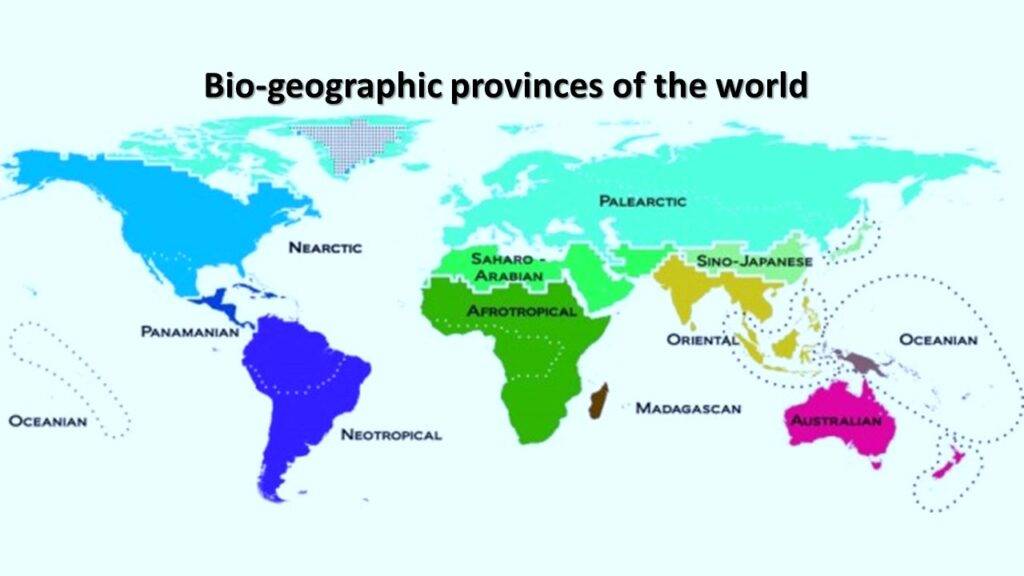
Welcome to the COMPETITIVE EXAM MCQs SERIES of ENVIRONMENTAL SCIENCE for UGC-NET/JRF, SLET, GATE, and other entrance tests – Bio-geographic provinces of the world.
Syllabus Outline
- Historical development and pioneers of Biogeography.
- Concepts of dispersal, migration, vicariance, and endemism.
- The role of geological events in shaping biogeographic patterns and the impact of environmental factors on species distribution.
- Definition and characteristics of biogeographic regions.
- Major biogeographic regions of the world (e.g., Nearctic, Palearctic, Neotropical, Afrotropical, Indomalayan, Australasian, and Antarctic).
- Boundaries and transitions between biogeographic regions.
- Factors influencing the delimitation of bio-geographic provinces.
- Examples of prominent bio-geographic provinces and their unique characteristics.
- Species-area relationships and their significance in conservation.
- The role of bio-geographic provinces in conservation planning.
- Conservation hotspots and their conservation significance.
- Predicted biogeographic shifts and their ecological consequences.
This quiz contains the concept-based most frequently asked 25 MCQs of Bio-geographic provinces of the world. Each question has a single correct/most appropriate answer.
1. The Great Barrier Reef, the world’s largest coral reef system, is located in which bio-geographic province?
a) Indo-Malay
b) Australasia
c) Nearctic
d) Neotropic
2. Assertion (A): The Palearctic bio-geographic province has a diverse temperate flora and fauna in Europe, Asia, and North Africa.
Reasoning (R): The Palearctic region experiences wide temperature variations, with cold winters and hot summers, creating suitable conditions for temperate species.
a) The A is true, but the R is false.
b) The A is false, but the R is true.
c) Both A and R are true, and the R is the correct explanation of the A.
d) Both A and R are true, but the R is not the correct explanation of the A.
3. The Ethiopian Region is a bio-geographic province located in which continent?
a) Asia
b) South America
c) Europe
d) Africa
4. Which bio-geographic province is known for its temperate rainforests, including the Great Bear Rainforest in Canada?
a) Neotropic
b) Indo-Malay
c) Nearctic
d) Palearctic
5. The Sahara Desert is part of which bio-geographic province?
a) Indo-Malay
b) Nearctic
c) Palearctic
d) Afrotropic
6. The California Floristic Province is known for its exceptional plant diversity and is located in which bio-geographic province?
a) Australasia
b) Nearctic
c) Neotropic
d) Palearctic
7. Which continents primarily cover the Mediterranean basin characterized by a unique climate and vegetation?
a) Antarctica and Europe
b) Australia and Oceania
c) South America and North America
d) Europe, Africa, and Asia
8. Assertion (A): The Afrotropic bio-geographic province is home to the Congo Basin, one of the world’s largest tropical rainforests.
Reasoning (R): The Afrotropic region includes Sub-Saharan Africa, where the Congo Basin is located, supporting diverse flora and fauna.
a) The A is false, but the R is true.
b) The A is true, but the R is false.
c) Both A and R are true, but the R is not the correct explanation of the A.
d) Both A and R are true, and the R is the correct explanation of the A.
9. The Amazon River flows through which bio-geographic province?
a) Afrotropic
b) Neotropic
c) Nearctic
d) Australasia
10. The Holarctic is a bio-geographic province that includes parts of which two continents?
a) Europe and Africa
b) Asia and Australia
c) North America and Europe
d) South America and Africa
11. Assertion (A): The Neotropic bio-geographic province includes the Amazon Rainforest, the largest tropical rainforest in the world.
Reasoning (R): The Neotropic region encompasses Central and South America, where the Amazon Rainforest is located, supporting a wide range of biodiversity.
a) The A is true, but the R is false.
b) Both A and R are true, and the R is the correct explanation of the A.
c) Both A and R are true, but the R is not the correct explanation of the A.
d) The A is false, but the R is true.
12. Assertion (A): The Wallace Line separates two bio-geographic provinces known for their distinct flora and fauna.
Reasoning (R): The Wallace Line is a transitional boundary between the islands of Bali and Lombok, marking the division between the Asian and Australian bio-geographic provinces.
a) Both A and R are true, but the R is not the correct explanation of the A.
b) The A is true, but the R is false.
c) The A is false, but the R is true.
d) Both A and R are true, and the R is the correct explanation of the A.
13. The Sundaland bio-geographic province includes parts of which two regions?
a) South America and Africa
b) Southeast Asia and the Malay Archipelago
c) Asia and Europe
d) Australia and Oceania
14. The Great Victoria Desert is located in which bio-geographic province?
a) Afrotropic
b) Australasia
c) Nearctic
d) Indo-Malay
15. The Great Dividing Range is a mountain range found in which bio-geographic province?
a) Nearctic
b) Australasia
c) Palearctic
d) Indo-Malay
16. The Wallace Line separates two bio-geographic provinces known for their distinct flora and fauna. Which are these two provinces?
a) Nearctic and Neotropic
b) Palearctic and Indo-Malay
c) Indo-Malay and Australasia
d) Neotropic and Australasia
17. Assertion (A): The Indo-Malay bio-geographic province is known for its high species diversity and includes the Sundaland region.
Reasoning (R): The Indo-Malay province encompasses Southeast Asia, parts of the Indian subcontinent, and the Malay Archipelago are rich in biodiversity.
a) Both A and R are true, and the R is the correct explanation of the A.
b) The A is false, but the R is true.
c) The A is true, but the R is false.
d) Both A and R are true, but the R is not the correct explanation of the A.
18. The Madrean Pine-Oak Woodlands, a bio-geographic province, is mainly found in which regions?
a) North America and South America
b) Africa and Antarctica
c) Australia and Oceania
d) Europe and Asia
19. The Thar Desert, also known as the Great Indian Desert, is part of which bio-geographic province?
a) Palearctic
b) Indo-Malay
c) Nearctic
d) Australasia
20. The Sonoran Desert, one of the hottest deserts in North America, is primarily located in which bio-geographic province?
a) Afrotropic
b) Neotropic
c) Nearctic
d) Indo-Malay
21. The Gulf of California is a characteristic feature of which bio-geographic province?
a) Australasia
b) Neotropic
c) Indo-Malay
d) Nearctic
22. The Siberian Taiga is a vast forested region found in which bio-geographic province?
a) Neotropic
b) Nearctic
c) Indo-Malay
d) Palearctic
23. The Mediterranean Basin bio-geographic province is known for its Mediterranean climate. Which countries border the Mediterranean Sea?
a) Australia and New Zealand
b) Turkey and Egypt
c) Spain and Portugal
d) Italy and Greece
24. Which bio-geographic province includes the Himalayan mountain range and is known for its rich plant and animal diversity?
a) Australasia
b) Nearctic
c) Indo-Malay
d) Palearctic
25. The Gondwana bio-geographic province was named after the ancient supercontinent. In which modern-day continent was this supercontinent primarily located?
a) Antarctica
b) Australia
c) South America
d) Africa
Previous: Resources and their assessment
Next: Agro-climatic zones of India
References
- Anil K. Tyagi (2018) Environmental Science and Engineering, Khanna Publishers, 3rd edition.
- Edward O. Wilson (2001) The Diversity of Life, Harvard University Press, 2nd edition.
- M. S. Manhas and A. H. Khan (2015) Environmental Geography, Rawat Publications, 3rd edition.

